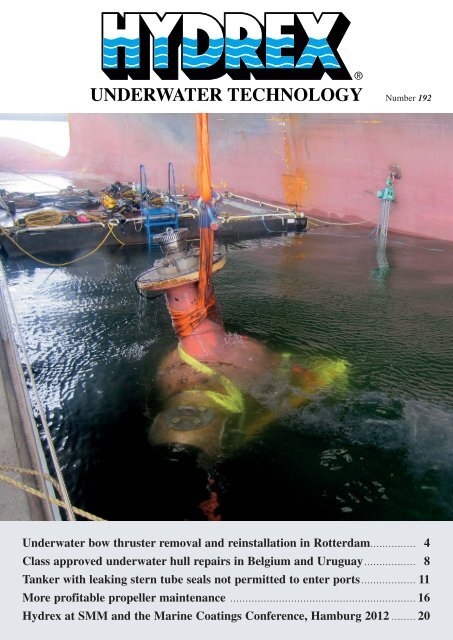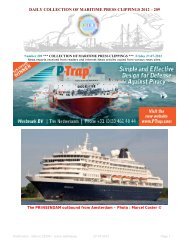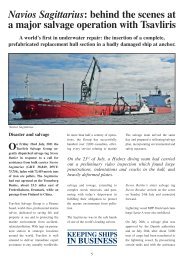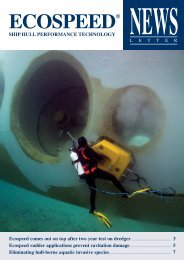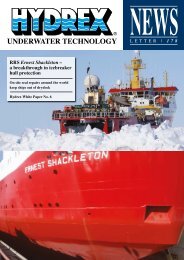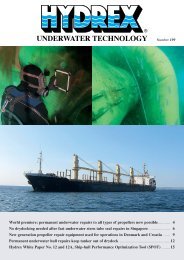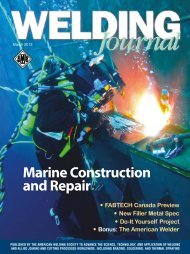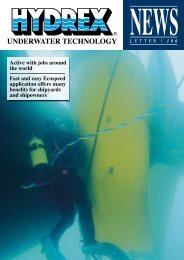Download - Hydrex Underwater Technology
Download - Hydrex Underwater Technology
Download - Hydrex Underwater Technology
You also want an ePaper? Increase the reach of your titles
YUMPU automatically turns print PDFs into web optimized ePapers that Google loves.
Coldstraighteningof severely bentpropeller bladesIn its quest to provide costeffective services to customers,<strong>Hydrex</strong> developed proceduresto address differentkinds of damage to propellers.This research led to the designof the <strong>Hydrex</strong> cold straighteningmachines first used in2002.New unit lowered into the water.By taking advantage of this techniquedamaged blades can bestraightened underwater, allowingthe ship to return to commercialoperations without the need todrydock. Blades can be broughtback close to their original form,restoring the propeller’s optimumefficiency.The <strong>Hydrex</strong> flexible mobdocks create a drydock-like environment underwater.The cold straightening machineshave been in use for quite sometime now but the <strong>Hydrex</strong> researchdepartment has beenlooking into ways to expand thetechnique even further to improveour services. A newversion of the straighteningmachine was recently put intopractice. It is compatible withthe existing models and is usedto restore more severely bentpropeller blades to their originalcondition.thruster propeller blades were thenreinstalled one by one and thethruster unit was reconnected to theengine room.The <strong>Hydrex</strong> team worked in shiftsaround the clock to finish the jobwithin the available time frame. Theship had to shift twice to continueits loading and unloading, but theflexibility of the diver/techniciansmade sure that this could be donewithout losing time.Performing both the removal andreinstallation on such a tight scheduletakes a lot of planning. This canonly be done successfully by peoplewho have familiarity with suchchallenges and the relevant knowhow.This is why <strong>Hydrex</strong> has a technicaldepartment capable of executingall the required planning, anin-house Research & Developmentdepartment that can take care of theengineering aspect of an operationand diver/technicians who are trainedand qualified to perform the fullrange of required class-approvedrepair procedures in even the harshestconditions. An effective, competentteam is the only way to consistentlyachieve a high quality result inthe short periods of time usuallyavailable to ships.6
Fast and high quality on-site repair services intheWestern Mediterranean area and North AfricaThe <strong>Hydrex</strong> office in Algecirasis ready to mobilize immediatelywith their two dedicated divesupport vessels. Both vessels arefully equipped as service stationsfor a wide range of repair operationsand allow for a fast responsein the bay of Algeciras, Gibraltarand North African ports.As part of the <strong>Hydrex</strong> group, <strong>Hydrex</strong>Spain takes advantage of the company’s38 years of experience. Alloperations are carried out by highlycertified diver/technicians all ofwhich have been trained in theheadquarters in Antwerp and haveextensive experience, enabling theoffice to offer their customers thehigh quality <strong>Hydrex</strong> is known for.Jobs recently carried out by <strong>Hydrex</strong>Spain include a propeller modification,pipe repairs, rudder repairs andstern tube seal repairs in Algeciras,propeller modifications in Cadiz andan azimuth bow thruster removal andreinstallation on a pipe laying vesselin Cartagena.<strong>Hydrex</strong> SpainPoligono Industrial Palmones IICalle Dragaminas Nave N2911370 Algeciras • SpainPhone: +34 956 675 049 (24/7)Fax: +34 956 921 914E-mail: info@hydrex.es<strong>Hydrex</strong> US ready to mobilize immediately<strong>Hydrex</strong> has an office located inClearwater in the TampaBay area that is ready to mobilizeimmediately. The office has a fastresponse center that is equippedwith an extensive range of state ofthe art logistics, trucks, tools anddiving support equipment. Thisenables <strong>Hydrex</strong> US to efficientlyservice vessels and offshore unitscalling on ports in Canada, North,Central and South America aswell as the Caribbean.All staff members of the <strong>Hydrex</strong>office in Clearwater undergo stringenttraining at the <strong>Hydrex</strong> headquartersin Antwerp. They can carryout both simple and complex highquality jobs even in the harshest ofcircumstances.Repairs to thrusters, propellers, rudders,stern tube seals, damaged orcorroded hulls and all other underwaterrepair and maintenance servicesare done while the vessel is onsite.This eliminates the need to drydock.All used methods are fully approvedby all major classification societies.www.hydrex.usKEEPING SHIPSIN BUSINESS<strong>Hydrex</strong> US604 Druid Rd,Clearwater, FL 33756Phone: +1 727 433 3900 (24/7)Fax: +1 727 433 3990info@hydrex.us
Class approved underwater hullrepairs in Belgium and UruguayRecently <strong>Hydrex</strong> teams ofdiver/technicians mobilizedto a 164-meter roro vessel berthedin Antwerp, Belgium and a 235-meter bulker at anchor in PuntaDel Este, Uruguay to performunderwater hull repairs. Despitethe smaller scale of these operationsthey are nonetheless vital forshipowners if they want to avoidunscheduled drydock visits fortheir vessels.<strong>Hydrex</strong> on-site hull repair servicesinclude the renewal of both smalland large areas of damaged hullplating. These repairs can be carriedout above or below water, accordingto the circumstances, with tailormademobdocks. Normal commercialactivities can therefore continuewithout disruption. These operationsfollow the <strong>Hydrex</strong> procedure for weldingcracks and inserts in the vessel's<strong>Hydrex</strong> diver/technician getting ready for underwater operation in Antwerp.shell plating and they are approved bythe major classification societies.<strong>Hydrex</strong> diver/technician teams carryout these on-site hull repairs allover the world. In most cases thedamaged area can be replaced witha permanent insert and no conditionof class is imposed. On the rareoccasions where the damage doesnot allow such a repair, as wasthe case in Uruguay, a temporarydoubler plate is installed over theaffected area. This allows theowners to keep to their schedule andhave a permanent repair carried outduring the next scheduled drydockvisit.On shore preparation during hull repair in Antwerp.8
New insert plate positioned andready for welding.Permanent insert repair inAntwerpA cavitation hole needed to berepaired in the shell plating of a164-meter roro during the ship’sstop in Antwerp. A <strong>Hydrex</strong> diver/technician team therefore carriedout a detailed inspection of boththe onboard as well as the water sideof the shell plating, after whichthey installed a cofferdam over theaffected area.This allowed them to remove theframe covering the damage and cutaway a round area with a diameter of300 mm. Next they positioned a newinsert plate of the same dimensionsand secured it with a full penetrationweld. An independent tester thencarried out ultrasonic testing and therepair was approved by the Lloyd’sRegister surveyor who was presentduring the operation. The diver/technicians then reinstalled theframe and removed the cofferdam,concluding the repair.Afloat doubler plate installationin Uruguay<strong>Hydrex</strong> was contacted to installa doubler plate over a groundingrelated crack located on the flatbottom area of the first port sideballast tank of a 235-meter bulkerin Punta Del Este. After arriving inUruguay, a diver/technician team setOn-site bowthrusteroperationsThe <strong>Hydrex</strong> lightweightflexible mobdocks aredesigned to be easily transportedaround the world andare used to close off thethruster tunnel on both sides,allowing divers to performrepairs and other operationsin a dry environment aroundthe bow thruster unit.This technique enables them toreinstall the propeller blades ofan overhauled thruster insidethe thruster tunnel after the unithas been secured or replace theblades or seals and performrepair work on a specific partwithout removing the unit.Since the development of thisflexible mobdock technique,numerous thruster repairs havebeen carried out by <strong>Hydrex</strong>diver/technicians around theworld.There is no need to send thevessel to drydock as all operationscan be carried out in portor while the vessel is stationaryat sea. Normal commercial activitiescan therefore continuewithout disruption.Phone: + 32 3 213 5300 (24/7)Fax: + 32 3 213 5321hydrex@hydrex.bewww.hydrex.beHeavily dented frames and shell plating on bulker in Uruguay.9
up a workstation on a workboat andsailed to the location of the vessel.L-shaped crack with crack arrests on both ends.A detailed inspection revealed thatthe L-shaped crack was 480-mmlong and between 4 and 8 mm wide.In the area of impact, a 250-mmdeep and 25-meter long indent wasalso found. In the ballast tank, theteam then removed the frames thathad bent during the grounding. Thisallowed the diver/technicians toaccess the damage and make crackarrests on both sides to prevent thecrack from spreading further. Theteam then installed a doubler plateover the crack on the water sideas well as the in board side. Thevessel could sail safely until thenext scheduled drydocking wherepermanent repairs will be carriedout.Welding work on the doubler plate inside the ballast tank in Uruguay.Repairs of this kind can only bedone rapidly and successfully bytrained divers/technicians who arefamiliar with them and who have therelevant know-how to resolve allof the technical difficulties encounteredduring underwater operations.This is why all <strong>Hydrex</strong> technicalstaff from all offices undergo stringenttraining after which they areable to perform a wide range of operations.Throughout these operationsthey stayed in close communicationwith each other and with the technicaldepartment in the office. Thisallowed them to finish these jobswithin the shortest possible timeframe and this without any compromiseof the high quality standards<strong>Hydrex</strong> is known for.Welded doubler plate on bulker in Uruguay.10
Tanker with leaking stern tubeseals not permitted to enter ports<strong>Underwater</strong> repair allows vessel to continue its scheduleWhen the fore as well as theaft stern tube seals of a247-meter tanker were leaking,the vessel was not given permissionto enter any ports. Unloadingthe vessel at sea and going to drydockseemed the only option forthe vessel, until <strong>Hydrex</strong> sent adiver/technician team with one ofthe company’s flexible mobdocksto the ship’s location in PortGentil, Gabon, to replace both setsof stern tube seals on-site.The team loaded the necessaryequipment on a barge on which theyset up a work station to monitor allunderwater activities. The bargethen sailed to the tanker and the<strong>Hydrex</strong> team leader met up with thevessel’s owner and superintendent.The rest of the diving team made allremaining preparations for the mainactivity, which started, immediatelyafter the meeting, with the removalof the rope guard. This was followedDiver/technician preparing the stern tube seal assembly for mobdock installation.by a thorough underwater inspectionand shaft wear down readings.While the <strong>Hydrex</strong> flexible mobdockwas installed around the stern tubeseal assembly to create a dry underwaterenvironment around the assem-bly, <strong>Hydrex</strong> technicians replacedthe fore stern tube seals which arelocated on the inside. Next the teamstarted the work on the aft seals.This was done inside the flexiblemobdock in drydock-like conditions,which are essential for sterntube seal repairs. The diver/technicianscleaned the entire assemblybefore they removed the damagedseals one by one and replaced themwith new ones. Like the fore seals,these were prepared onshore by theattending Aegir-Marine specialist.All parts of the stern tube sealassembly were then reinstalled andsecured. After a successful leakagetest the team removed the flexiblemobdock and repositioned the ropeguard.<strong>Hydrex</strong> diver working on stern tube seal assembly in Gabon.11
If you have receivedthis magazine atthe wrong address orif your company isgoing to move,please let us know.You cancontact us at:<strong>Hydrex</strong>@hydrex.beor at+ 32 3 213 53 00Grinding work on the stern tube edge.The flexible mobdock allows stern tube seal repairs on-siteand underwater.<strong>Hydrex</strong> diver preparing the stern tube area for theoperation.Diver preparing the reinstallation of the rope guard.Stern tube assembly with new seals.By sending the <strong>Hydrex</strong> flexiblemobdocks in our special fly awaycases together with all equipment,fast response to any emergency calllike this is guaranteed to locationsaround the world from the various<strong>Hydrex</strong> offices. Every day a ship hasto go off hire causes a substantialloss of money, and having to arrangethe vessel to be unloaded at seawould have been an organizationaland financial disaster for the owner.By performing both the repair onsiteand underwater, <strong>Hydrex</strong> madesure that the vessel could keep to itssailing schedule and did not have togo into drydock.12
The <strong>Hydrex</strong> flexible mobdock creates a dry environmentaround the stern tube seals.During stern tube seal operation in Port Gentil.<strong>Hydrex</strong>Permanent rudder repairs nowpossible without drydockinghas developed an entirelynew method enabling permanentrepairs of rudders withoutdrydocking the ship. Permanentrepairs were hitherto not possibleand ships had to drydock in case amajor defect was found. The newlydesigned equipment is lightweightand can be mobilized very rapidlyin our special flight containers.Therefore this new service is nowavailable worldwide.Major defects on rudders very oftencause unscheduled drydocking ofships. The new method designed byour technical department allows engineers,welders and inspectors to performtheir tasks in dry conditions.Class approved permanent repairson-site, without moving the ship,are now possible and commercialoperations can continue. Steel repairsand replacements can be performedand pintle and bushing defects can besolved without the loss of time andmoney associated with drydocking.The equipment can be mobilized withinhours to any port in the world and isavailable for rapid mobilization from the<strong>Hydrex</strong> headquarters in Antwerp.13
KEEPING SHIPSIN BUSINESS15
More profitable propellermaintenanceAship’s propeller representsonly a very small fraction ofthe vessel’s wetted surface area.Yet the effects of a rough propelleron the vessel’s fuel consumptionis comparatively large. The costof remedying a rough propellercompared to that of dealing withan entire rough and fouled hullis very minor. Thus remedies fora rough propeller are not onlysimple and quick to execute, theyalso represent a fast, high returnon investment. The best availablepractices for propeller maintenanceare more efficient thanthose currently in general use.Propeller roughness: CausesNew propellers can be relativelysmooth or rough as a result oftheir manufacture. They invariablybecome rougher during service.The main reasons for increasedroughness include the followinggeneral categories:• marine fouling• calcareous deposit (chalk layer)• impingement attack• corrosion• cavitation erosion• mechanical damage from impactwith objectsA smaller propeller, half-fouled and rough, half-polished.• improper polishing or cleaningMost propellers are made of abronze alloy and are uncoated. Thetip of a propeller can be travelingat speeds of 100-120 kph throughthe water. The water contains saltand other abrasives. The propeller isalso a cathode in the electrolytic cellcreated by hull and propeller. Thedynamics of the propeller in thewater creates cavitation. Marinegrowth attaches to the propelleras it does to any other object immersedin the water. Thus a numberof different elements conspire todamage and roughen the propeller’s16
surface and reduce its efficiency.The salt water corrodes the bronzethrough a chemical reaction. Electrolysiscauses erosion and alsoresults in the build-up of a rough calcareousdeposit. Cavitation damageshows up in the form of a pitted surface.Biofouling in the form ofslime, weed, barnacles and otherorganisms adds to the surface roughness.The impingement attack consists ofthe abrasives in the water actingagainst the rapid motion of the propeller,affecting the tips and leadingedges. The tips in particular arelikely to come in contact withsolid objects of one type or anothercausing mechanical damage.These different causes tend to worktogether, with each source of roughnesscomplementing the other sourcesand accelerating the propeller’sdecline in overall smoothness. Therougher a propeller is allowed tobecome before the condition isremedied, the more rapidly furtherroughness will accrue. It is an acceleratingdownward spiral.But this is a double-edged sword.Effectively dealing with one sourceof roughness will diminish theeffects of the others. By frequentmaintenance, the overall decline canbe greatly diminished.EffectsA rough propeller results in a fuelpenalty for the ship. How large thatpenalty is depends on the degree ofroughness. In practice it is not veryeasy to separate the fuel penaltyarising from propeller roughnessfrom the fuel penalty associatedwith a rough and fouled hull. Veryoften one sees figures for combinedhull and propeller fouling fuel penalties.Nevertheless there is dataavailable which gives an indicationof the fuel penalty associated withpropeller roughness on its own. Inthe book Marine Fouling and itsPrevention by the Woods HoleOceanographic Institution (1952)tests involving the destroyerMcCormick are described. In sevenmonths out of dock the average fuelconsumption to maintain a givenspeed was up to 115.8 per centcompared to unfouled hull and propeller.The propeller alone wascleaned and consumption droppedto 105.5 per cent, showing that thepropeller fouling/roughness aloneresulted in a 10 per cent increase infuel consumption. iIn his “Green ship of the Future”seminar at Asia Pacific Maritime inSingapore in March 2010, ChristianSchack of FORCE <strong>Technology</strong>states that the added annual fuelconsumption of a Panamax containership due to propeller foulingmay be up by 5-6%. iiIn Chapter 7 of Advances in marineantifouling coatings and technologies,the authors, T. Munk and D.Kane estimate that increases in fuelconsumption from normal propellerfouling range from 6% to 14% citingHaslbeck, 2003. iiiIn that same chapter of Advances inmarine antifouling coatings andtechnologies, the authors cite theperformance increases after propellerpolishing on container ships: at24 knots, the propeller polishing atsix-month intervals resulted in a fuelsavings of five tons per day for eachpropeller polish.In its Naval Ships’ TechnicalManual, the US Navy estimates thatapproximately 50 per cent of fuelsavings attained by full hull cleaningcan be attributed to the cleaningof propellers and shafts. ivIn An Introduction to Dry Docking,the authors state that “even a 1mmlayer of accumulated fouling orcalcium deposits on a propeller willsignificantly increase its roughness,and within 12 months or so canincrease an ISO class I to an ISOclass II, or a class II to a III. Thiscauses large increases in fuelconsumption. Practical figures andelaborate tests indicate a 6 to 12%gain in fuel consumption in polishinga propeller from a class III conditionto a class I condition. Somepropellers support marine growthup to 20 mm thick, which obviouslyhas a major effect.” vBased on information available, itcan be seen that propeller surfaceroughness from fouling and surfacedeterioration can cause a fuel consumptionpenalty of somewherebetween 5 and 15 per cent.At current fuel prices, the fuel penaltyfrom a rough propeller adds up toa lot of money. Conversely, thesavings attainable from keeping aship’s propeller clean and smoothare significant.Current propeller maintenancepracticesShipowners/operators, technical superintendentsand those responsiblefor keeping ships operating efficientlyare aware that there is a fuelpenalty associated with rough, fouledpropellers. It is common for somemaintenance measures to be in forceto take care of this.These measures usually consist ofscheduled propeller polishing. Oftenthis is done only when a ship goesto drydock. Since this might beevery 2 ½ - 4 years, it is too infrequentto keep a propeller operatingat optimum efficiency.17
Some vessel operators thereforeschedule in-water propeller polishing,perhaps once or twice per yearwhich in most cases is still notfrequently enough.While most ship propellers are baremetal, some experimentation hasbeen carried out to try to remedysome of the propeller’s inherentproblems through the applicationof various coatings. While no universal,fully workable and testedsolution has yet been placed on themarket, this line of research showspromise.In general, most ships afloat havepropellers which are rough enoughto cause a sizable fuel penalty.The weakness in currentpracticesIf a propeller is not maintained withsufficient frequency but is allowedto become quite rough and fouled,then economic and environmentalproblems ensue. The economic problemis the additional fuel penaltywhich could have been avoided hadthe propeller been cleaned or polishedsooner. This brings with it theadditional emissions of CO2, NOx,SOx and particulate matter whichthe additional fuel consumptionentails.Restoring a very rough propeller toits original state (or close to it)requires grinding away a considerableamount of the material itself,mostly copper but also zinc, nickeland other metals from which thepropeller is made. While the amountof material removed from a singlepropeller may be relatively small,when this is multiplied across all thepropellers used in the entire worldfleet, this polishing can represent asignificant emission of heavy metalsand thus pollution and contaminationof water column and sedimentwhich cannot be ignored.Badly done polishing with a polishingdisc or grinding wheel can initself create a rougher surface thanthat of the new propeller, leavingscratches which not only increasethe propeller’s roughness but alsoinvite easier attachment of foulingorganisms.It is the infrequency and poor qualityof cleaning or polishing whichare the major drawbacks of propellermaintenance practices which currentlyprevail.Propeller maintenance bestpracticesCaught early enough, the propellercan be cleaned with a rotating brushand abrasive material removingalmost no metal, preventing theeffects of cavitation damage fromspiraling and avoiding the formationof calcium deposits. This earlyattention can speed up the cleaningprocess considerably, extending theuseful life of the propeller andpreventing the emission of heavymetals into the water and sediment.This approach also eliminates thedangers of a roughened surface dueto inexpert grinding and polishing.Economically, the fuel saving fromthe more frequent cleaning of apropeller before it has becomeseriously fouled and rough greatlyoutweighs the cost of the cleaningitself. This propeller cleaning canbe combined with a general hullinspection by divers making it evenmore economically viable.The trick in establishing the bestpractices for propeller maintenance,assuming an uncoated propeller, isto work out a routine for propellercleaning which permits rapid, easy(and therefore economical) propellercleaning which is frequent enough tominimize the fuel penalty from propellerroughness and foulingand which results in the minimumremoval of propeller material inorder to achieve a smooth, fuel-efficientsurface.As stated in Marine Propellers andPropulsion by John Carlton, “Withregard to the frequency of propellerpolishing there is a consensus of opinionbetween many authorities thatit should be undertaken in accordancewith the saying ‘little and often’by experienced and specialized personnel.”viOf course propeller cleaning canbe overdone. Scheduling propellercleaning once a week would notprove to be economically viable.However, cleaning a propeller onceevery month or every two monthswould in many cases be optimum.If carried out this frequently, cleaningwith a relatively soft brushand abrasives is adequate to keep awell-maintained propeller smoothenough for maximum fuel savings.It would prevent the acceleratingspiral of cavitation damage pluscorrosion plus fouling which, ifallowed to continue uninterrupted,requires major polishing with grindingor polishing wheel and theremoval of a great deal of metal intothe marine environment if thepolishing is carried out in the water.Cleaning propellers “little andoften” would be beneficial to the environmentas a minimum of copper,zinc, nickel and other heavy metalswould be ground off into the water.Case studyA recent experiment was carriedout with a 134-meter cruise ship.The propellers were cleaned witha rotating brush alone, no grinding18
or polishing disk required, by oneof the ship’s crew who is a diver.It took one diver approximately40 minutes to complete the cleaningof the ship’s two propellers. Thefouling was not very heavy sincethe propeller is cleaned quite often.Calculations of subsequent fuelsavings showed that on a 30-hourtrip from Aruba to Barbados, theship saved $2,100 compared to thesame trip with a mildly fouled propeller.The ship consumes 1.6-1.7tons/hour of fuel. The fuel saving asa result of cleaning the propeller wascalculated at 6%. A 30 hour trip withthe propeller before cleaning wouldhave used 51 tons of fuel which is$35,700 at $700 per ton. 6 per centof $35,700 is $2,142. In this case thepropeller cleaning was carried outby a member of the crew. Had thepropeller been cleaned by an outsidecompany it would not have costmore than about $2,000. So the costof cleaning, even if carried out bya contractor, would have been recoupedin the first trip the ship tookafter cleaning. Since the propellerwould not have had to be cleanedagain for at least a month or two, thecost of the cleaning would have beenrecouped many times over.Cost of cleaningObviously the cost of cleaning is afactor which cannot be overlooked.If the savings in fuel costs did notsubstantially outweigh the cost ofpropeller maintenance, then onewould question the value of frequentpropeller cleaning.The cost varies from one location toanother and from one provider toanother. Cheapest is not always best.The need for skilled and competentpropeller cleaning and polishing hasalready been stressed.Vendors usually charge per propellersize and number of blades. Polishinga 4-blade, 6-meter propeller wouldcost somewhere between $1,900 and$3,000. Polishing a 6-blade, 8-meterpropeller might cost between $3,100and $4,000. The costs vary by locationand company.One of the better propeller cleaningvendors charges 15-20% less forpropeller cleaning (brush plus abrasives)than for full polishing withgrinding or polishing discs. Whichmethod is used depends on howrough the propeller is and this isdetermined largely by how frequentlyor infrequently the propeller ispolished or cleaned.As covered in the short case studyabove, the cost of the propellercleaning can be recouped in thefirst voyage the ship makes after thecleaning. Not only is it cheaper toclean than to polish, it also is economicallyadvantageous.Cleaning takes less time than polishing.The best companies offeringpropeller cleaning and polishing canpolish a large propeller in about fourhours.ConclusionBest available practices for propellerefficiency at this time consist ofthe use of uncoated propellers withfrequent, routine in-water cleaningto prevent heavy fouling, the formationof a calcareous deposit layerand the spiraling damage of cavitationerosion and corrosion.Further research is needed into theuse of strongly adherent, highlycavitation and corrosion resistantglass or ceramic reinforced coatingswhich can stand up to the extremelychallenging conditions in whichpropellers operate.Until such technology has beenperfected and proven in service,frequent light cleaning remains thebest technology available.This article appeared originally inthe June 2012 issue of Ship & Offshoremagazine (www.shipandoffshore.net) and is reprinted here withthe permission of Ship & Offshore.i Woods Hole Oceanographic Institution, Marine Fouling and its Prevention, US Naval Institute, (1952), pp 32-33ii Christian Schack, FORCE <strong>Technology</strong> (presentation) March 2010. http://www.greenship.org/fpublic/greenship/dokumenter/APM%20Singapore/7%20Force%20Technologies%20%20Operational%20initiatives%20to%20reduce%20emissions%20from%20ships.pdf accessed16 April 2012.iii T. Munk, D. Kane, D. M. Yebra, “The effects of corrosion and fouling on the performance of ocean-going vessels: a naval architecturalperspective,” Chapter 7 of Advances in marine antifouling coatings and technologies, edited by Claire Hellio and Diego Yebra, WoodheadPublishing in Materials, (2009) p 161iv Naval Sea Systems Command, Naval Ships’ Technical Manual Chapter 081 “Waterborne <strong>Underwater</strong> Hull Cleaning of Navy Ships,” Revision5, 1 Oct 2006, 081-2.1.1.1v David Martin et al. An Introduction to Dry Docking, http://www.angelfire.com/rnb/drydocking/home.htm, accessed March 2012.vi John Carlton, Marine Propellers and Propulsion (Second Edition), Butterworth-Heinemann Elsevier, (2007), p 383.19
<strong>Hydrex</strong> at SMM and the MarineCoatings Conference, Hamburg 2012The 25 th shipbuilding, machineryand marine technology(SMM) international trade fairin Hamburg in September 2012was attended by more than 50,000trade visitors from all parts ofthe world. The 2,100 exhibitors,including <strong>Hydrex</strong>, spread out over90,000 square meters, were verysatisfied with the fair. Even theweather was kind with dry andsunny days right up until it wastime to take down the booths onthe last day, September 7, whenthe rain began.According to the closing report on thetrade show, “The largest group ofvisitors was from shipowners andshipping companies, followed by theshipbuilding and shipyard industry,and machinery and plant builders.The naval and defense industrymoved up to fourth position. SMM2012 had 35% of its trade visitorsfrom abroad, up two percentagepoints from the previous SMM. Theshare of Asian visitors was double thenumber at SMM 2010, now 16%.”<strong>Hydrex</strong> and EcospeedCertainly the <strong>Hydrex</strong>/Ecospeed boothbore out Mr. Schramm’s statementwith floods of visitors keen to findout how they could convert fromconventional coatings with theirThe <strong>Hydrex</strong> booth on a busy thoroughfare at SMM.biocides to a non-biocidal costeffectiveand better alternative,Ecospeed.Clearly visible at the end of the longoutdoor space between halls B4 andB5 and on the route for all visitorsEnvironmental emphasis“It was clearly evident at SMM2012 that the shipowners have toinvest in a green future, more thanever before,” observed TorstenSchramm, Chief Operating Officerat Germanischer Lloyd and GlobalMaritime Environmental Congress(GMEC) Chairman. “Everywhere inthe maritime business and industrythere are new products and processes,aimed at increasing energyefficiency and reducing emissions –for individual ships and for wholefleets.”Many visitors enjoyed the relaxed, businesslike atmosphere at the <strong>Hydrex</strong> booth.20
Smouts, <strong>Hydrex</strong> Equipment Officer,and his team performed flawlesslyand efficiently in setting up andtaking down the <strong>Hydrex</strong> booth andmaking sure that it had everythingthat was needed, was roomy, comfortable,well stocked and generallyfit for purpose, not an easy feat whenthe logistic lines from Antwerp toHamburg are considered, but onethat is typical of any <strong>Hydrex</strong> mobilizationfor any job anywhere in theworld.<strong>Hydrex</strong> CEO, Boud Van Rompay, talking to visitors at the <strong>Hydrex</strong> booth.Protective Coatings EuropeMarine Coatings Conference2012passing between halls, the yellow<strong>Hydrex</strong>/Ecospeed tent was a popularspot.The <strong>Hydrex</strong> tent was well mannedby Dave Bleyenberg, Manuel Hof,Sam Williams, Pierre Klein, andDavid Phillips, and CEO Boud VanRompay was present for the entireevent. The booth maintained afriendly, busy atmosphere throughoutthe four-day show.Many existing customers, <strong>Hydrex</strong>agents, technical people from allphases of shipbuilding and maintenanceand many interested newcomersto <strong>Hydrex</strong> and Ecospeeddropped by and enjoyed the friendly,comfortable but businesslikeand informative atmosphere of the<strong>Hydrex</strong> booth. Much new businesswas conducted.As usual, in the background KoenIntegrated into the SMM schedule,Protective Coatings Europe hostedthe 2012 Marine Coatings Conferenceon September 5 th and 6 th in oneof the conference rooms in hall B3of the Hamburg Fair. The conferencewas chaired by Brian Goldie,Technical Editor of ProtectiveCoatings Europe magazine andspeakers on the first day includedrepresentatives of Safinah Ltd.(UK), ABS (UK), Huntsman Pigments(UK), IMC Engineering(Italy), Jotun (Norway), Nippon(Japan) and <strong>Hydrex</strong> (Belgium).The first day of presentation wasfollowed by a panel discussionwith representatives of all the majorbottom paint manufacturers includingPPG, Jotun, Hempel, InternationalPaint, Sherwin-Williams,Nippon Paint and <strong>Hydrex</strong> (CEOBoud Van Rompay).On the second day another series ofspeakers from a variety of internationalcompanies including DCNS(France), Leighs Paints, Exova(UK), Optimiza (Spain), TQC (NL),Meyerwerft (Germany) and others.David Phillips, Communications Exec for <strong>Hydrex</strong>, gives a presentation onhull-borne invasive species at the Marine Coatings Conference during SMM,Brian Goldie presiding (rear left).21
Marine Coatings Conference panel discussion, <strong>Hydrex</strong> CEO Boud Van Rompay center, Raouf Kattan at the podium, theother panelists being representatives from the major hull paint manufacturers.The subject matter was varied but allhighly relevant to the overall subjectof marine coatings.The aim of the conference was toprovide a forum for the exchange ofinformation on best practices fromexperts in coatings, shipbuilding andenvironmental protection.<strong>Hydrex</strong> representative, David Phillips,Communications Exec, presented apaper entitled, “Eliminating Hull-Borne Aquatic Invasive Species –An alternate, practical approach,”which provided a very different,non-toxic approach to limitingthe spread of NIS worldwide. Thepresentation was generally wellreceived,opened some eyes andraised some eyebrows (the subjectof the talk was by its nature a disruptivetechnology which tends toswim against the current and disturbthe status quo).The panel session on hullcoatings/fuel savings/emissions which followedwas led by Raouf Kattan,Managing Director of Safinah Ltd.,a Coating Consultant based in NewcastleUK. <strong>Hydrex</strong> was representedby CEO Boud Van Rompay, whowas able to provide valuable andin many cases surprising answersand information to questions fromthe attendees, stating the case veryclearly for a non-toxic approachto underwater hull protection andfouling control.Mr. Kjolberg of Jotun made the casefor insisting on numerical metricsfor coatings fuel efficiency ratherthan relying on anecdotal claimsfrom manufacturers. The paneldiscussion was lively with manyquestions answered at some lengthby the panelists. The attendees wereinterested and involved.Summary<strong>Hydrex</strong> CEO Boud Van Rompay (center), representatives for International Paint(left) and Jotun (right) during panel discussion.All in all SMM 2012 was the bestSMM yet for <strong>Hydrex</strong> and we wouldlike to thank all of you who visitedus there for coming and look forwardto working with you on anongoing basis. We are looking forwardto the next SMM in Hamburgin 2014 and will see you all there.22
Easy and effective propeller cleaningThe effect of a rough propelleron the vessel’s fuelconsumption is big. The costof remedying a rough propelleris very minor. Remediesfor a rough propeller are notonly simple and quick toexecute, they also represent afast, high return on investment.A rough propeller results in afuel penalty for the ship. Howlarge that penalty is dependson the degree of roughness. Atcurrent fuel prices, the fuel penaltyfrom a rough propeller addsup to a high cost. Conversely, thesavings attainable from keeping aship’s propeller clean and smoothare significant.Cleaning a propeller once everymonth or every two months wouldin many cases be optimum. Ifcarried out this frequently, cleaningwith a relatively soft tool isadequate to keep a well-maintainedpropeller smooth enoughfor maximum fuel savings.Thanks to its network of officesand service stations, <strong>Hydrex</strong>can offer propeller cleaningson a worldwide basis. Theseoperations are carried out usingunderwater equipment designedand developed in-house specificallyfor propeller maintenance.<strong>Hydrex</strong> combines this servicewith underwater inspectionswhere this is economically advantageousto the shipowner oroperator.Phone: +32 3 213 5300 (24/7)Fax: +32 3 213 5321E-mail: hydrex@hydrex.bewww.hydrex.be
<strong>Hydrex</strong> offers turnkey underwaterrepair solutions to shipownerswherever and wheneverthey are needed. <strong>Hydrex</strong>’s multidisciplinaryteam will help you findthe best solution for any problemencountered with your ship belowthe water line. We will immediatelymobilize our diver/technicians tocarry out necessary repair workwithout the need to drydock.<strong>Hydrex</strong> has a long track record ofFast underwater repairskeep ships out of drydockperforming complex permanent underwaterrepairs to thrusters, propellers,rudders, stern tube seals and damagedor corroded hulls. By creatingdrydock-like conditions around theaffected area, our diver/technicianscan carry out these operations in portor at anchor.All the projects we undertake areengineered and carried out in closecooperation with the customer andany third party suppliers, relievingthe customer of all the hassle of coordination,planning and supervision.Headquartered in the Belgian port ofAntwerp, we have offices in Tampa(U.S.A), Algeciras (Spain), Visakhapatnam(India), and Port Gentil(Gabon).All <strong>Hydrex</strong> offices have fully operationalfast response centers where anextensive range of state-of-the-artequipment is available at all times.Headquarters <strong>Hydrex</strong> N.V. - AntwerpPhone: + 32 3 213 5300 (24/7)E-mail: hydrex@hydrex.be<strong>Hydrex</strong> Spain - AlgecirasPhone: + 34 (956) 675 049 (24/7)E-mail: info@hydrex.es<strong>Hydrex</strong> LLC - Tampa, U.S.A.Phone: + 1 727 443 3900 (24/7)E-mail: info@hydrex.us<strong>Hydrex</strong> West Africa – Port Gentil, GabonPhone: + 241 04 16 49 48 (24/7)E-mail: westafrica@hydrex.bewww.hydrex.be<strong>Hydrex</strong> India -VishakhapatnamE-mail: vishakhapatnam@hydrex.be


